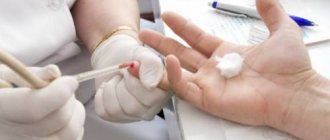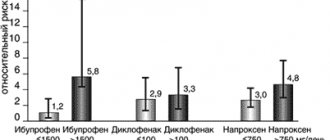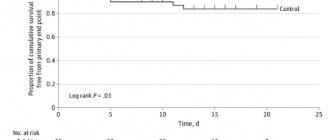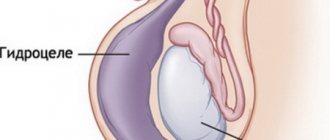Blood provides metabolism, nutrition and even respiration for all cells and tissues in the body. Doctors always closely monitor its indicators, using tests to determine the presence of certain diseases that destroy the body from the inside without visible symptoms. That is why blood tests are regularly taken: both for preventive purposes and to make a more accurate diagnosis.
One of the most important components of blood are red blood cells or, as they are also called, red cells. They have a disc-shaped, doubly concave shape and perform one of the most important functions in the body - transporting oxygen to cells and carbon dioxide for its removal. Their size is not as important as their volume. In a healthy person, the volume of all red blood cells should be approximately the same, or with slight deviations from the norm; in the case of pathology, different cells appear. To identify such abnormalities, a blood test for RDW is performed.
The abbreviation RDW stands for Red Cells Indicies and translated means “red blood cell distribution width.” This indicator can be found in the results of a general blood test, since a separate study of red blood cells is not carried out. It has two markers:
- RDW-CV: shows how much cell size differs from the average (measured as a percentage)
- RDW-SD: Reflects the difference in size between the smallest and largest red blood cells (measured in femtoliters).
Indications for testing
Often, such an analysis is preventive and is taken on a regular basis (on average once a year) to identify diseases in the early stages, when they are much faster and easier to treat. It is prescribed to pregnant women to monitor their general condition and identify problems such as anemia, and for inpatient monitoring.
A general blood test is required during hospitalization to conduct a basic examination and obtain a more accurate picture of the disease, as well as before surgery to prevent possible complications. If the body is severely weakened, this may indicate that the person will not survive the operation; in such cases, it is necessary to undergo preliminary treatment for recovery.
The analysis is prescribed to identify and diagnose different types of anemia, as well as for possible diseases of the hematopoietic system. A general blood test helps track dynamics during monitoring of ongoing treatment, accurately determining the onset of improvements or deteriorations in the body’s condition, which helps to timely adjust treatment. It can be prescribed by a physician, general practitioner, surgeon, neurologist and hematologist.
Reasons for increasing RDW
Nutrient deficiency
Deficiencies of various nutrients can cause an increase in RDW, for example:
- Iron deficiency [r, r, r, r]
- Folic acid deficiency [R]
- Vitamin B12 deficiency [r, r]
This is because your body needs these nutrients to produce healthy red blood cells. Any of these deficiencies can eventually lead to anemia.
Inflammation
Some studies suggest that higher RDW values are associated with inflammation and higher levels of inflammatory cytokines such as IL-6, IL-8 and TNF-alpha. [r, r, r, r, r, r, r]
Inflammatory cytokines can interfere with red blood cell production and thereby increase RDW. Additionally, oxidative stress, which often accompanies chronic inflammation, can reduce red blood cell lifespan and further increase RDW values. [R, R]
High RDW has been found in people with diseases associated with inflammation, such as inflammatory bowel disease, celiac disease, polycystic ovary syndrome (PCOS), and major depressive disorder (MDD). [r, r, r, r]
REASONS FOR INCREASING RDW
Sleep disorders
In a study of 17,500 adults, those who slept less or more than 7-8 hours a night were more likely to have high RDW values. This was especially true for people who slept 10 hours a night - their chances of having increased RDW increased by almost 70%. [R]
RDW values are higher in people with sleep apnea. [r, r]
RDW scores were also associated with shift work with circadian rhythm disruption. In a study of 7,000 women, those who worked shift shifts were almost 50% more likely to experience an increase in RDW compared to women who worked day shifts. [R]
Bleeding
Severe and moderate injuries with heavy bleeding increase RDW. [R] Bleeding may not be visible, as is the case with intestinal and gastric bleeding. [r, r]
Blood transfusion
If a person undergoes multiple blood transfusions, their RDW may increase due to differences in blood composition between the donor and recipient. [r, r]
Liver disease
Increases in RDW occur in a variety of liver diseases, including hepatitis, alcoholic cirrhosis, biliary cirrhosis, and liver cancer. [R]
An observational study of 423 adults with liver disease found that their RDW was significantly higher than that of healthy controls. [R]
In another study of 446 hepatitis B patients, increasing RDW levels corresponded with increased liver size (hepatomegaly) and increased inflammation. [R]
Kidney disease
One of the kidney hormones, erythropoietin, is needed for the maturation of blood cells. Problems with the production of this hormone occur with kidney disease, leading to the development of RDW. [R] People with reduced kidney function have higher RDW levels. [R]
Alcoholism
Alcoholics can exhibit high RDW values without liver disease. This is because alcohol can have a toxic effect on red blood cells. [R]
Thalassemia
Thalassemia may cause increased RDW values. However, patients with thalassemia may also demonstrate normal RDW levels. [r, r, r]
Sickle cell anemia and hereditary spherocytosis
Sickle cell anemia is an inherited disease. People with this disease have higher RDW values because many of their red blood cells are misshapen. [R]
Hereditary spherocytosis (Minkowski-Choffard disease), another disease in which red blood cells become misshapen, also causes increased RDW levels. [r, r]
DISEASES IN WHICH RDW LEVELS INCREASE (https://medcraveonline.com)
Cancer
RDW rates are often higher in a variety of cancers, including stomach cancer, liver cancer, colon cancer, and kidney cancer. [r, r, r, r]
There are many factors in cancer that can interfere with the normal production of blood cells, including chronic inflammation and poor nutrition.
In cancer, RDW often increases with disease severity and metastasis. [R]
In a study of 25,000 people, the risk of cancer was 30% higher in those people who showed the highest RDW values compared to people with the lowest values. Postmenopausal women with the highest RDW values had a 22% increased risk of developing cancer. But no association was found between RDW values and cancer in premenopausal women. [R]
Cardiovascular diseases
According to a meta-analysis, an increase in RDW levels accompanies various cardiovascular diseases: acute coronary syndrome (including myocardial infarction), coronary heart disease, peripheral arterial disease, arterial hypertension, and also with atrial fibrillation. Higher RDW values predict more negative outcomes for these diseases.
Increased RDW has been associated with various types of cardiovascular disease in studies. [r, r, r]
In a study of 25,500 adults, each 1% increase in RDW resulted in a 13% increase in heart attack risk. Those people who showed low RDW values had a 71% reduced risk of having a heart attack (myocardial infarction) compared to people with the highest RDW levels. [R]
Elevated levels of RDW are associated with a high risk of cholesterol plaque building up in the arteries (atherosclerosis) in patients with hypertension. [R]
RWD is associated with autoimmune diseases
There is an association between high RDW levels and increased disease activity in autoimmune problems such as rheumatoid arthritis, lupus, psoriasis, Crohn's disease, Sjögren's syndrome, systemic scleroderma, and ankylosing spondylitis (ankylosing spondylitis). [r, r, r, r, r, r, r]
INCREASING RDW WITH INCREASING CROHN'S DISEASE/ULCERATIVE COLITIS ACTIVITY (https://www.wjgnet.com)
RWD and metabolic syndrome
People with higher levels of RDW show more advanced degrees of metabolic syndrome. This was found in studies involving more than 217,000 people. [r, r]
RWD and diabetes risk
In a study that monitored more than 2,600 people with normal blood glucose levels over 4 years, high RDW values increased the risk of developing diabetes by nearly 2 times compared to people with low RDW. [R]
RWD and risk of dementia (dementia)
In a study of approximately 2,500 older adults, higher RDW values had an increased risk of dementia. This risk was significant in those people who were not anemic. [R]
RWD is associated with mortality
High RDW values increase inflammation and oxidative stress, which contribute to the risk of mortality. In various studies, adult (45+) hospital patients with elevated RDW levels demonstrated a higher risk of cardiovascular mortality, infection, and all-cause mortality. [r, r, r]
Additionally, in a review of 13 studies (involving 10,410 patients), low RDW was associated with a lower risk of mortality. [R]
RDW and depression
The study, which followed 43,226 patients with depression for 5.3 years, measured RDW values at the time of diagnosis and in subsequent contacts with doctors. It was found that patients with cardiovascular diseases with increasing RDW had more advanced depressive syndromes.
Blood levels
As mentioned above, the RDW indicator has two markers: RDW-CV and RDW-SD, each of which has its own units of measurement and content standards. Next we will look at each of them.
RDW-CV reflects the deviation of red blood cell size from the average, measured as a percentage and has different standards depending on the person’s age.
- Children under 6 months: from 14.9 to 18.7%
- Children over 6 months: from 11.6 to 14.8%
- Adults: 11.5 – 14.5%
RDW-SD shows deviations in the distribution of red blood cells by volume and is measured in femtoliters. The standard deviation is 37 – 54 femtoliters, regardless of age or gender.
RDW increased: association with diseases
Elevated RDW values may indicate, but do not diagnose or confirm, the following diseases: [p, p, p, p]
- Lack of iron in the body or vitamin deficiency
- Lack of B vitamins, including B12 and folic acid
- Anemia (various types, including sickle cell anemia)
- Inflammation
- Insomnia
- Cardiovascular diseases
- Blood loss due to hemorrhage (including surgery)
- Thalassemia
- Liver disease
- Kidney disease
- Cancer
- Alzheimer's disease
- Alcoholism
- and others.
However, RDW may still be at normal levels in people with leukemia, or with certain types of anemia (such as aplastic anemia). Therefore, it is important to look not only at the RDW value, but also at the relationship with other markers. [R]
Deviations from the norm (what they talk about)
Before talking about the possible reasons for deviations in this indicator, it is worth noting that it is not specific and cannot serve to accurately determine a particular disease. RDW is analyzed only in conjunction with other data from a general and biochemical blood test. So, if there is a slight deviation from the norm, but other indicators do not cause concern, then, most likely, this simply indicates the characteristics of the body, but to make a more accurate diagnosis, you need to consult a doctor.
An increase in RDW is normal only for newborns under 6 months of age. There is also a slight increase as a result of recent nervous stress and after a blood transfusion, but in all other cases, elevated results indicate the presence of the disease. They may indicate various types of anemia:
- Anemia of megaloblastic, myelodysplastic and siderablastic types
- Anemia with heterogeneity in red blood cell size (most often due to diet)
- Anemia due to impaired myelopoiesis
- Anemia due to chronic diseases
- Anemia due to acute blood loss (may indicate internal bleeding)
- Aplastic anemia
Also, elevated RDW levels may indicate the following diseases:
- Some homozygous hemoglobinopathies and homozygous thalassemias
- Increased reticulocyte count
- Hyperglycemia
- Congenital genetic diseases
Reduced indicators do not indicate the presence of any abnormality or disease, therefore such values are not taken into account during the examination. Most likely, this is a variant of the norm.
Increased level
If RDW in a blood test is increased by more than 15%, this indicates the presence of pathological processes in the body. At the same time, there are more large red blood cells in the patient’s blood than usual. This may be hazardous to your health. Such cells live too little; in addition, the largest of them may have a volume larger than the lumen of some vessels. Therefore, these cells quickly disintegrate, due to which a lot of iron is released and bilirubin is formed. As a result, the load on the liver and spleen increases. And the amount of hemoglobin decreases, so oxygen reaches the tissues unevenly.
A change in the volume of red blood cells can lead to the development of serious pathologies.
Sometimes such results are a temporary condition and are therefore considered a false positive. This happens during cold aggregation, that is, red blood cells sticking together under the influence of low temperatures. In addition, a temporary increase in RDW levels may occur after surgery or blood transfusion.
But most often the causes of this condition are the following pathologies:
- macrocytic, megaloblastic or iron deficiency anemia;
- hemoglobinopathy;
- alcoholic liver damage;
- other chronic liver pathologists;
- thalassemia;
- deficiency of vitamin A, folic acid, vitamins B9 and B12;
- increased level of white blood cells;
- malignant tumors affecting the bone marrow;
- Alzheimer's disease;
- serious disorders of the cardiovascular system;
- heavy metal poisoning.
It is especially important to identify disorders in a pregnant woman in a timely manner. This will help avoid serious complications and abnormalities in the child’s development due to oxygen starvation.
How the research works
In modern medicine, equipment plays an important role in treatment. the same can be said about a blood test. On an empty stomach, blood is drawn either from a vein in the elbow or from a finger (this method is especially often practiced in the case of children), and then all the work is transferred to a modern analyzer, which conducts research quickly and with high quality, giving an accurate result .
It counts the number of red blood cells of different sizes per microliter of blood, calculates the average cell size and determines the degree of deviation from the norm of this indicator. The largest and smallest cells are also measured and the difference between this spread and the possible norm is analyzed. This indicator is recorded in femtoliters.
Of course, the equipment may not always be accurate; maximum accuracy of results can only be obtained by manual counting, but this is a very long and labor-intensive process, which is practically not used in modern medicine.
If deviations in this indicator occur, the blood test is performed again to obtain a reliable result, because the diagnosis cannot be made as a result of a single blood sample.
When is such an analysis prescribed?
The RDW value is determined by a general blood test. It is taken on an empty stomach, from a vein in adults, and from a finger in small children. Such an examination is necessary in order to timely identify possible pathological conditions, clarify the diagnosis or monitor the correctness of the prescribed therapy. Such tests are necessary for pregnant women, as well as for patients before surgery.
Research is being conducted on RDW not only in adults. It is very important for children. From about six months of age, a child’s blood composition should be the same as that of an adult. Determining the RDW level allows you to timely identify various deviations in its development. This analysis is especially indicative for diagnosing iron deficiency anemia, lack of folic acid or vitamin B12. It allows timely detection of congenital pathologies of the hematopoietic system, for example, thalassemia, as well as the presence of malignant tumors.
Such tests in a child are very important, as they allow timely detection of pathologies.
In addition, doctors prescribe this test for adults and children when the following symptoms appear:
- general malaise, weakness, fatigue;
- drowsiness during the day, decreased performance;
- causeless increase in body temperature;
- increased sweating;
- sudden mood swings;
- dryness and pallor of the skin, sometimes slightly yellowing.
Preparation for the procedure
Since taking blood for a general analysis does not imply anything unusual, and the study itself is carried out regularly for almost all people, preparation does not require a person to take any special measures, but no one has canceled the standard recommendations before taking tests so that the results are reliable and correctly reflect the clinical picture:
- The RDW test is taken in the morning and on an empty stomach. Dinner in the evening of the previous day before donating blood should be light and at least 8 hours should pass between the last meal and the test, and preferably 12
- It is highly not recommended to drink alcohol 2 days before the test, as it can significantly distort the results
- It is advisable to give up fatty and fried foods, which have a negative effect on the body, 2 days in advance.
- You should not take a blood test after physiological and x-ray procedures
- It is recommended to refrain from smoking one hour before blood collection.
- It is advisable to exclude any physical and emotional stress; before the analysis, a 15-minute break and complete calm are required.
- Particular attention must be paid to the medications you are taking. Almost any medicine can distort the results of a blood test, so before donating blood you need to consult with a specialist: you may have to stop taking the medicine for a while to get an accurate clinical picture, or simply take the drug after the test.
If a repeat blood test is prescribed, it must be taken at the same time (since the composition of the blood may depend on the body’s circadian rhythms) and in the same laboratory. This is due to the fact that units and methods of measurement may vary between laboratories. Only if all recommended measures are followed will the result of the study be correct.
What to do
Many pathologies that cause changes in the composition of the blood do not manifest themselves externally in the initial stages. This is why it is so important to have regular blood tests. Determining the RDW level will allow timely diagnosis of many diseases.
After receiving such test results, it is necessary to undergo additional examination. It will help determine why changes in blood composition are observed and what pathologies are causing this. Sometimes you can return normal blood counts by changing your diet, which will compensate for the lack of essential microelements. But most often, such disorders can be eliminated only after the underlying disease has been cured.
Analysis for RDW in MedArt
The medical laboratory is equipped with modern high-precision equipment, high-quality reagents, all necessary consumables and qualified personnel. Our clients can rest assured of the reliability: if all preparation recommendations are followed, the results obtained will be 100% accurate. rdw in the blood test is reduced
Our team performs the work quickly, efficiently and with due understanding. Since there are people who are catastrophically afraid of any medical intervention, including blood sampling, we try to provide all our clients with the most comfortable and calm atmosphere, while performing all hematological studies at the highest level and providing accurate results.
With us, you can take a general blood test in a calm and comfortable environment and get a reliable result in the shortest possible time at an affordable price, without waiting in line for long hours, and then endlessly visiting doctors in an attempt to find out the result. We care about each of our clients and strive to do our work with the highest quality possible.
RDW reduced
A low RDW value indicates that your red blood cells are uniform in size, which is desirable for health. [R] However, it is worth remembering that there is still a possibility of having some kind of disease. [R]
For example, with reduced RDW values, one may suspect disturbances in the functioning of the spleen, where damaged red blood cells are recycled. In addition, if RDW is low, it is worth thinking about the following possible reasons:
- Recent surgery
- Blood donation
- Severe blood loss (including hidden in the stomach and intestines)
- Hormonal disorders during pregnancy, puberty, and when taking contraceptives
Ways to reduce RWD
First of all, it is necessary to treat the underlying disease - the cause of increased RDW values. Below are additional options that can help you improve your health and reduce your RDW.
Balanced diet
Eating a healthy and balanced diet helps prevent nutritional deficiencies. It is especially important that the diet contains the recommended amounts of iron, folic acid and vitamin B12. [, , ] Correcting nutritional deficiencies can improve blood cell production and lower RDW values.
Reduce alcohol consumption
Reducing alcohol consumption may help reduce damage to red blood cells. [, ] Additionally, alcohol also reduces the absorption of nutrients such as vitamin B12 and folic acid, which are essential for the production of red blood cells. [, ]
More physical activity
People who do little or no physical activity show higher levels of RDW. [, ]
Exercise, including light intensity exercise, has been shown in research to improve RDW scores. [, , ]
In a study of more than 8,000 people, as the amount of exercise time per week increased, the risk of showing increased levels of RDW decreased by 11%. []
Quit smoking
Smoking increases oxidative stress. Higher RDWs are identified in smokers and are associated with the number of cigarettes smoked per day as well as the duration of smoking. []
Decoding the results
The interpretation of the analysis is carried out only by a doctor. Having noticed an mcv value that is outside the normal range in the results, the specialist must determine the reasons for such a violation. For this purpose, additional diagnostics are carried out, which includes a survey and study of the patient’s medical history.
It is important to find factors in a person’s life that provoke a decrease or increase in the volume of red blood cells
If diagnostics reveals the presence of a disease, efforts must be directed toward its treatment. The medications that will be used in this case, affecting a specific problem, will help restore the required volume of red blood cells. There are no medications that can simply affect the mcv value in the blood, and taking them would be inappropriate, since the deviation of this indicator itself is not a disease
It is important to understand what exactly provokes its change
If the reason for the violation of the norm of red blood cells is an incorrect lifestyle or the consequences of treating a serious disease with antibiotics, the patient’s efforts must be directed to restoring the body. Healthy sleep, moderate exercise, proper nutrition and taking vitamin complexes will help restore the desired shape and normal value of red blood cells.
It is important to get advice from a qualified specialist and not to neglect the problem, so as not to treat its complications later. Normal red blood cells, called normocytes, are round, flat cells that are concave on both sides
This shape allows for maximum diffusion surface area while maintaining volume and can easily pass through narrow curved sections of the circulatory system. The MCV indicator in the blood (abbreviation for English mean cell volume, which means “average cell volume”) determines the average volume of a red blood cell
Normal red blood cells, called normocytes, are round, flat cells that are concave on both sides. This shape allows for maximum diffusion surface area while maintaining volume and can easily pass through narrow curved sections of the circulatory system. The MCV indicator in the blood (abbreviation for English mean cell volume, which means “average cell volume”) determines the average volume of a red blood cell.
If the average volume of erythrocytes is normal, the development of normocytic anemia is assumed, it occurs:
- hemolytic;
- aplastic;
- hemorrhagic;
- hepatic;
- endocrine.
High rate
When red cells are abundant, this indicates that the patient is developing macrocytic anemia.
The occurrence of this problem can be due to various reasons:
- lack of microelements (B12);
- lack of folic acid;
- megaloblastic anemia;
- presence of oncological education;
- hypothyroidism;
- malabsorption in the intestine;
- liver problems;
- myxedema;
- problems with the pancreas;
- diseased bone marrow with high leukocytosis;
- drug poisoning;
- alcohol toxicosis.
Frequent bleeding leads to a high index.
In some cases, macrocytosis occurs after long-term use of antidepressants. However, a clear connection with this fact has not been established.
The first signs of high erythrocytosis are blush on the face, redness of the skin on the body, headaches, and dizziness.
Low values
When the mcv value is low, this indicates the presence of microcytic anemia, which is a consequence of:
- chronic diseases and infections;
- iron deficiency;
- development of malignant tumors;
- lead poisoning;
- low hemoglobin levels;
- hereditary anemia;
- taking certain medications.
MCV less than normal is recorded with hypochromic anemia, microcytosis, or decreased hemoglobin synthesis. The latter directly affects the shape and fullness of red cells.
If there is less hemoglobin present than necessary, the red blood cells show less volume. Its synthesis also decreases when a person is sick with a genetic blood disease - thalassemia.
If someone experiences weakness, fatigue, tinnitus, absent-mindedness, severe pallor of the skin and memory impairment, he should consult a doctor. The number of red blood cells or their volume may have decreased.
Cell Variability
A person may show more than just an increase or decrease in MCV. In some cases, anisocytosis is diagnosed.
With this pathology, a microscope reveals many cells of different sizes, causing the blood to become too thick. The MCV indicator is closely related to another indicator, such as RDW, which characterizes the variability of cells in size.







